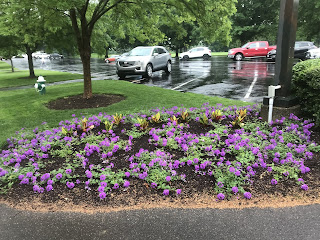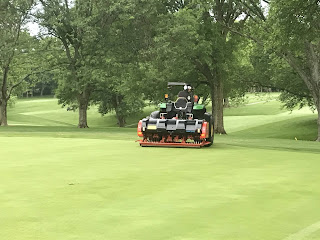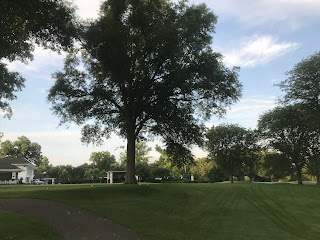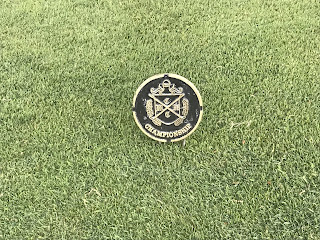May is usually the busiest month of the year for the agronomy team and this year was no exception. Getting the spring annuals replaced with the summer flowers and mowing have been two of the most time consuming activities that have taken place. The tulips put on a great display and now have been replaced with many different flowering annuals. We are fortunate to have many girls working on our crew this year that are either enrolled in a horticulture related program, or are interested in the profession. They have been doing a great job putting together the summer display.
 |
| Purple verbenea and crotons |
 |
| Starlight rose zinnia and elephant ears |
 |
| Yellow lantana and Caladiums |
On the other hand, keeping up with mowing has been a tall task, especially after the grass explodes with growth coming out of winter dormancy and from fall/spring nitrogen feedings. We have been doing a good job keeping up with the mowing on greens, tees, and fairways. However, the rough is the biggest turf area we have on the golf course and occasionally after a rain event, it can get long and "rough." Most of March and April had been on the drier side, but once May hit, rain storms hit with more frequency. Rain hinders our ability to mow the rough without leaving tracks and tearing up areas of turf. Sometimes it is better to wait until conditions are drier rather than destroying grass. One day of not mowing makes us play catch up for the rest of the week, and consequently the rough is higher than desired. Of course, there are times when multiple rain events coincide and we have to be aggressive and mow in wet conditions, but this is the exception and not the rule. We ask for patience during wet weather and understand that the rough may be a little higher than expected.
The green's cultural practices have been running smoothly. Verticutting and light frequent topdressings have taken place since the beginning of the golf season. The new spinning topdresser that was purchased last year has allowed us to make lighter topdressing applications; increasing the green's firmness and the speed of the putting surfaces. Deep-tine aeration was accomplished on June 1st. Wehrkamp enterprises was used to aerate the greens using 5/16th inch solid tines and a heavier topdressing was applied after. The tines were small enough that the impact on golfers should be minimal and aerating this late in the spring season will help the greens get through the hot, dry summer weather.
 |
| Aerating of the putting green |
 |
| Putting green after a heavier topdressing |
 |
| Verticutting a green |
 |
| Lightly topdressing after verticutting |
Tree work has been accomplished around the putting green and #1 and #6 tees. The pin oak next to the putting green collar has been removed due to the putting green expansion project taking place in the late summer. The two pin oak trees by #1 tee and #6 tee had dead wood and low limbs taken out for safety concerns and to improve visibility while looking at the course from the patio area. Finally, the pin oak by #1 tee received a cable to support its co-dominant branch structure.
 |
| Pin oak by putting green before removal |
 |
| Tree company at work |
 |
| Putting green area after pin oak removal |
 |
| Pin oak behind #1 tee trimmed/pruned and a cable inserted between co-dominant branches |
New tee markers have replaced the 25 year old markers that were showing their age. The new markers were designed, deliberated, and eventually approved by two different committees and departments. The updated design reflects the Country Club's current logo, and they are colored for easier recognition of which tees to play from, especially for guests. These markers should last for at least another 25 years.
 |
| Old tee marker with old logo |
 |
| New blue combo tee |
 |
| New black (Championship) tee |
The cicadas are out in full force. The male's serenading music is almost deafening at times and dead cicadas are dotting many of the greens, especially ones underneath trees. The females are just beginning to deposit their eggs in tree branches so it may be another month before we see any signs of tree damage.
Herbicide applications are being applied to rough, fairway, and tee areas to decrease the amount of broadleaf weeds on the golf course. Clover is not an easy weed to eradicate and persistence is the only chance of decreasing it. We will continue to make herbicide applications until the weather gets too hot and herbicide spray is not recommended.
 |
| Rough herbicide application |
Currently, labor is an issue in many industries. The landscape/grounds industry has not been spared and it has been extremely difficult recruiting and hiring the right employees. The old way of most employees working full-time hours seems to be a thing of the past. The majority of the newer generation workers and the older, retired generation workers want flexible, part-time work. So to attract more interested employees, and to meet this limited working hours demand, we have increased our seasonal part-time staff by 100% (from 10 to 20). This requires more training, but gives us the opportunity to sub workers in when others are off or on vacation. I'm not sure if this is a trend that is here to stay or Covid related, but the Grounds Department is adapting to the changes and is getting work accomplished. We just ask for patience as we delve into this uncharted territory.
There are many projects on the horizon including landscape lighting to illuminate the Champion overcup oak tree, and cart path repairs. I will continue to update as these activities take place.
Brad Piecuch
Grounds Superintendent


















No comments:
Post a Comment
Note: Only a member of this blog may post a comment.